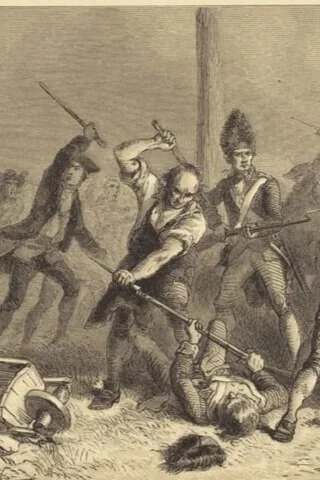In Service to the New Nation: An Interview with Robb K. Haberman of The John Jay Papers Project
Interviewed by Helena Yoo Roth
Few political leaders in the revolutionary and early nationals eras were more influential than John Jay (1745-1829). A New Yorker born and bred and a 1765 graduate of the nascent King’s College, this austere lawyer of Huguenot and Dutch descent went on to lead a life marked by continuous service and a steadfast devotion to his family, state, and country. The John Jay Papers Project based at the Rare Book & Manuscript Library at Columbia University has documented Jay’s life through a series of published volumes containing his personal correspondence and public papers.
Read MoreMyles Cooper and “the Din of War”
By Christopher F. Minty
Rev. Charles Inglis was distraught. “I cannot express the Distress I felt at hearing of your Embarkation for England, & the Cause of it,” he wrote. It was June 1775 and Myles Cooper, his close friend and colleague, had recently departed Manhattan for Britain. Cooper, one of the city’s most prominent and outspoken loyalists, and had long been targeted by revolutionaries. Just a few months before, he was among five New Yorkers who were warned in a April 25, 1775 letter from “Three Millions” that Parliament’s “Repeated insults and unparalleled oppressions” had reduced colonial Americans “to a state of desperation.”
Read MoreMonuments of Colonial New York: George III and Liberty Poles
Wendy Bellion and Shira Lurie
For the last installment in our six-part series on monuments in / about colonial Gotham, Wendy Bellion and Shira Lurie discuss NYC’s rebellion against British rule during the volatile decade before the War for Independence. Bellion begins with a story of destruction — the tearing down of the statue of George III in Bowling Green. Lurie tells of construction — the raising of five liberty poles on the Common (present day City Hall Park).
Read MoreA Loyalist and His Newspaper in Revolutionary New York
By Joseph M. Adelman
New York in the 1760s was a divided town, riven by local factions as well as imperial politics. Local elections were fiercely contested, as they had been for decades. The imperial crisis didn’t help.
Read MoreRevolutionary Networks: The Business and Politics of Printing the News, 1763-1789
Reviewed by Jonathan W. Wilson
Have pity for John Holt. He lived in perilous times. As the publisher of the New-York Journal, and as a centrally located postmaster, Holt was poised to play an important role in the American Revolution. His evident sympathies were with the patriots. But he had to be careful.
Read MoreThe Carleton Commission and Evidence of Arson in the Great New York Fire of 1776
By Bruce Twickler
In October of 1783, just six weeks before the British evacuated New York, the Commander-in Chief-of the British forces, Sir Guy Carleton, commissioned a panel of three British officers to investigate the disastrous fire that devastated the city seven years earlier. Shortly after midnight on September 21, 1776, fire had erupted in lower Manhattan. By daybreak it had consumed five hundred buildings – including schools, churches, warehouses and homes – and caused more destruction than all the previous colonial fires in New York combined.
Read MoreIconoclasm in New York: Revolution to Reenactment
Reviewed by Benjamin L. Carp
New York is a city of destruction. What doesn’t burn by accident, somebody tears down on purpose. When Chip asks Hildy to take him to the Hippodrome in Leonard Bernstein’s On the Town, she replies, “It ain’t there anymore,” which might as well be the city’s motto. Nothing is too sacred to shatter. Nothing is too exalted to escape the city’s brutal contests over money and power.
Read MoreThe Upper Barracks: Military Geography in the Heart of New York
By John Gilbert McCurdy
In October 1757, the New York Common Council authorized the construction of the Upper Barracks. It was to be a massive building: 420 feet long and 20 feet wide, consisting of two stories and enough space to sleep 800 men. Such a structure dwarfed anything else in the city; it was longer than a city block and twice as large as Trinity Church. The Committee for the Building of the New Barracks situated the barracks at what was then the northern edge of New York, placing them on the city common where Broadway split into roads leading to the suburbs of Greenwich Village and the Bowery. As carpenters set to work, the Upper Barracks claimed a privileged position in New York, placing the city under the watchful gaze of the British army.
Read More"Republics are not ungrateful": The American Revolution and Memory in New York City
By Jonah Estess
Four years before Abraham Lincoln was elected as president of a house divided, John McKesson Jr. (1807-1893) of Olcott, McKesson and Company (now the McKesson Corporation) petitioned Congress on a matter having to do with the very revolution that established the now troubled union. He had requested that Congress redeem continental currency paid to his great-uncle, John McKesson (1734-1798) — a practicing lawyer in New York City — likely for his services as secretary to the New York Provincial Congress, to the New York Committee of Safety, and to the New York State Convention on the ratification of the U.S. Constitution. McKesson Jr. expressed a belief that Congress remained indebted to his great-uncle for his service to the cause of American independence. But by virtue of blood relation, he requested that some repayment be paid to him.
Read More




